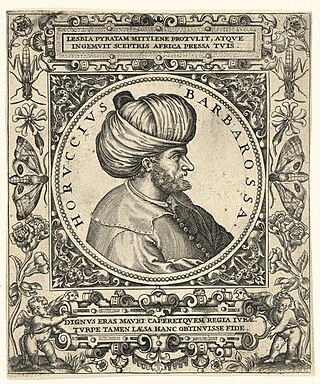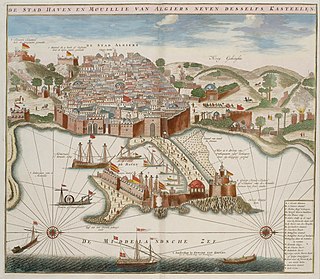
The Regency of Algiers was a largely independent tributary state of the Ottoman Empire during the early modern period, located on the Barbary Coast of North Africa from 1516 to 1830. Founded by the corsair brothers Aruj and Hayreddin Barbarossa, the Regency was a formidable pirate base infamous for its corsairs. First ruled by Ottoman regents, it later became a sovereign military republic that plundered and waged maritime holy war against European Christian powers.

Aruj Barbarossa, known as Oruç Reis to the Turks, was an Ottoman corsair who became Sultan of Algiers. The elder brother of the famous Ottoman admiral Hayreddin Barbarossa, he was born on the Ottoman island of Midilli and died in battle against the Spanish at Tlemcen.

The Battle of Isly was fought on August 14, 1844 between France and Morocco, near the Isly River. French forces under Marshal Thomas Robert Bugeaud routed a much larger, but poorly organized, Moroccan force, mainly fighters from the tribes of Beni Snassen, but also from the Beni Angad and Beni Oukil; under Muhammad, son of the Sultan of Morocco, Abd al-Rahman. Bugeaud, attempting to complete the French conquest of Algeria, instigated the battle without a declaration of war in order to force negotiations concerning Moroccan support for the Algerian resistance leader Abd el-Kader to conclude on terms favorable to the French who demanded the Sultan of Morocco to withdraw support for Abd el-Kader.
Salah Rais was the 7th King of Algiers, an Ottoman privateer and admiral. He is alternatively referred to as Sala Reis, Salih Rais, Salek Rais and Cale Arraez in several European sources, particularly in Spain, France and Italy.

The 1541 Algiers expedition occurred when Charles V of the Holy Roman Empire and king of Spain attempted to lead an amphibious attack against the Regency of Algiers, in modern Algeria. Inadequate planning, particularly against unfavourable weather, led to the failure of the expedition.

Between April and June 1563 the Regency of Algiers launched a major military campaign to retake the Spanish military-bases of Oran and Mers el Kébir on the North African coast, occupied by Spain since 1505. The sieges of Oran and Mers El Kébir of 1563 represented a major Hispano-Algerian episode in the larger Ottoman-Habsburg wars of the Mediterranean. The Kingdom of Algiers, the Principalities of Kabyle, and other vassal tribes combined forces as one army under Hasan Pasha, son of Hayreddin Barbarossa, and Jafar Catania. The Spanish commander brothers, Alonso de Córdoba Count of Alcaudete and Martín de Córdoba, managed to hold the strongholds of Oran and Mers El Kébir, respectively, until the relief fleet of Francisco de Mendoza arrived to successfully defeat the offensive.

The 2nd Bombardment of Algiers took place between 12 and 21 July 1784. A joint Spanish-Neapolitan-Maltese-Portuguese fleet commanded by the Spanish Admiral Antonio Barceló bombarded the city, which was the main base of the Barbary corsairs, with the aim of forcing them to interrupt their activities. The second bombardment followed a similarly failed expedition the preceding year.
The Expedition of Mostaganem occurred in 1558, when Spanish forces attempted to capture the city of Mostaganem. The expedition was supposed to be a decisive step in the conquest of the Ottoman base of Algiers, but it ended in failure, and has been called a "disaster".
Hasan Pasha was the son of Hayreddin Barbarossa and three-times Beylerbey of the Regency of Algiers. His mother was a Moorish woman from Algiers. He succeeded his father as ruler of Algiers, and replaced Barbarossa's deputy Hasan Agha, who had been effectively holding the position of ruler of Algiers since 1533.
The Battle of Wadi al-Laban occurred in March–April 1558 between Saadians and Ottoman Algerian forces under Hasan Pasha, the son of Hayreddin Barbarossa. It took place north of Fes, at Wadi al-Laban, an affluent of the Sebou River, one day north of Fes.

The capture of Algiers in 1516 was accomplished by the brothers Oruç and Hayreddin Barbarossa against Sālim al-Tūmī, the ruler of the city of Algiers, which was followed by an unsuccessful military campaign by the Spanish Empire and the Sheikh of Ténès to overthrow the newly formed Sultanate of Algiers.

Turkey–Morocco relations are the foreign relations between Morocco and Turkey, and spanned a period of several centuries, from the early 16th century when the Ottoman Empire neighbored Morocco to until modern times.
Martín Alonso Fernández de Córdoba Montemayor y Velasco was a Spanish nobleman, first Count of Alcaudete, Viceroy of Navarra, and governor of Oran.
The Campaign of Tlemcen or Tlemcen campaign was a military operation led by the Saadians of Mohammed ash-Sheikh against Tlemcen in 1557, then under the domination of the Regency of Algiers, a vassal state of the Ottoman Empire. Mohammed ash-Sheikh, who wanted to conquer Algeria, occupied the city but failed to seize the Mechouar Palace, which was defended by a garrison of 500 men under the command of Caïd Saffa.

The Campaign of Tlemcen (1551) was a military operation led by the Regency of Algiers under Hasan Pasha and his ally Abdelaziz, following the capture of Tlemcen by the Saadi Sultanate in June 1550.
Mustapha Bouchelaghem, also known as Bey Bouchelaghem was the Bey of the Western Beylik from 1686 to 1734/37.
The Expedition to Mostaganem of 1547 was a failed Spanish expedition mounted against Mostaganem by the Spanish forces of Count Alcaudete.
The Battle of Oued Zadidja occurred in 1551 after the Saadians violated an alliance with the Regency of Algiers, the Saadians were defeated and their leader was killed.
Alfonso de Córdoba y Velasco was a Spanish nobleman, II Count of Alcaudete, Viceroy of Navarra, and governor of Oran.








